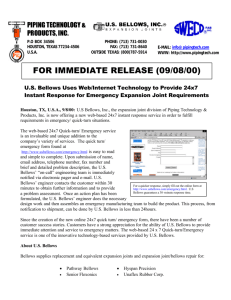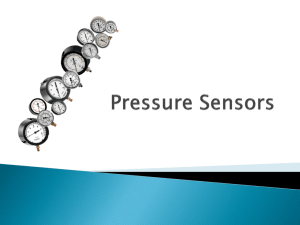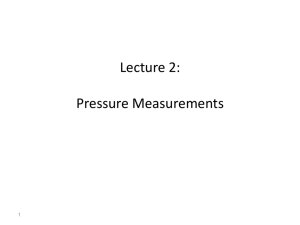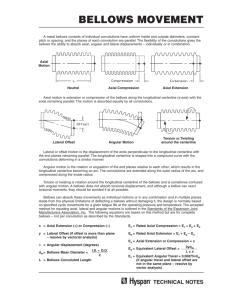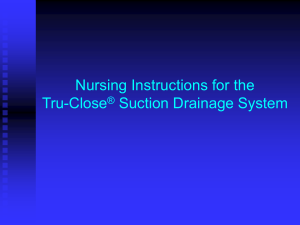SEP 16 2009 LIBRARIES
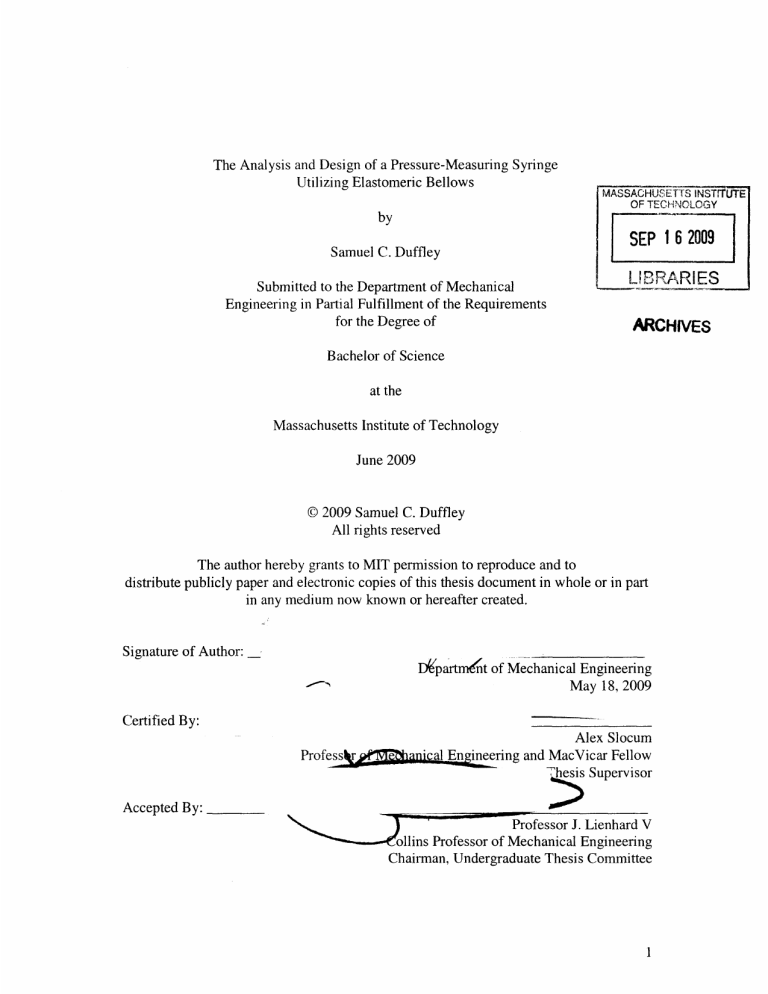
The Analysis and Design of a Pressure-Measuring Syringe
Utilizing Elastomeric Bellows by
Samuel C. Duffley
Submitted to the Department of Mechanical
Engineering in Partial Fulfillment of the Requirements for the Degree of
Bachelor of Science at the
Massachusetts Institute of Technology
June 2009
MASSACHUSETTS INSTFjTE
OF TECHNIOCLOGY
SEP 16 2009
LIBRARIES
ARCHIVES
© 2009 Samuel C. Duffley
All rights reserved
The author hereby grants to MIT permission to reproduce and to distribute publicly paper and electronic copies of this thesis document in whole or in part in any medium now known or hereafter created.
Signature of Author:
Certified By:
Professhr
DbIpartment of Mechanical Engineering
May 18, 2009
Alex Slocum anical Engieering and MacVicar Fellow hesis Supervisor
AcceP ted1 R v
Professor J. Lienhard V ollins Professor of Mechanical Engineering
Chairman, Undergraduate Thesis Committee
The Analysis and Design of a Pressure-Measuring Syringe
Utilizing Elastomeric Bellows by
Samuel C. Duffley
Submitted to the Department of Mechanical Engineering on May 18, 2009 in Partial Fulfillment of the
Requirements for the Degree of Bachelor of Science in
Mechanical Engineering
ABSTRACT
Endotracheal tube insertion requires the measurement of very low pressure. Currently, there exists no reliable method or device that is integral with the inflation syringe for measuring this pressure. Thus, a device for quickly and easily reading the pressure was created within the syringe currently used to pressurize the tube. This device takes the form of elastomeric bellows. These bellows were analyzed to determine the optimum geometry for the pressures involved in the procedure. Although no closed-form model exists for this analysis, FEA was used to obtain accurate results. Using the optimized bellows, a complete for-manufacturing design was created. This design concept has received much acclaim from the medical community and has great promise in transforming many medical procedures which require such measurement.
Thesis Supervisor: Alex Slocum
Title: Professor of Mechanical Engineering and MacVicar Fellow
Introduction
Endotracheal tubes (ETTs) are continually used in medical situations. They provide a clear airway from the mouth to the trachea so that oxygen can be moved in and out of the lungs by medical staff or equipment. Doctors use ETTs during most procedures involving general anesthesia and throughout intensive care wards. Endotracheal tubes' necessity causes their widespread use throughout medicine. There are two major parts to the ETT (see figure 1). The first is the airway, a long plastic tube that, when the whole tube is inserted, runs from the trachea out the mouth and is the line used to move air in and out of the lungs. The second module is just as critical. For the whole tube to function correctly, there needs to exist a seal between the main tube and the trachea. This allows the lungs to be pressurized without loss past the tube. It also prevents material getting past the other way and keeps the lungs clear. This seal is accomplished with the ETT cuff. This balloon surrounds the main tube towards its end and is deflated during insertion. After the endotracheal tube is inserted past the throat, doctors use a second, smaller tube that runs along the main tube to pressurize the cuff. A syringe is typically used to pump air to the balloon. The pressure used to seal the tube to the trachea is critical. Too low and the cuff will not seal adequately. Too high and the capillaries in the trachea get overwhelmed, causing pain and, if left long enough in that state, necrosis.
This range is also very small, ranging from 20 cm H
2
0 to 30 cm H
2
0 (2-3 kPa).
Cuff,
P i
P
Patm
To the respira±or
Figure 1: ETT after insertion into a patient. Note the pressures called out.
Currently, doctors can determine this pressure in many different ways. The first is manual palpation. At the end of the tube running from the cuff out the mouth is a small bulb. Since this volume is directly connected to the cuff, as pressure in the cuff increases, so does the pressure in the bulb. Doctors then palpate the bulb to determine its stiffness, which directly correlates to cuff pressure. This method, however, is very inaccurate as shown in many studies. One conducted by the Pentagon shows that the cuff pressure is wrong 72% of the time when this technique is used, 26% low and 46% high [1,2].
Another approach involves a monometer. A stopcock is attached to the cuff line.
From the stopcock, one line goes to the usual syringe and the other to the manometer.
The stopcock is initially switched to allow doctors to pressurize the cuff with the syringe.
After some air has been inserted into the cuff, the stopcock is switched to the monometer and the pressure read. There are two major problems with this method. The first is that during the measurement, pressure is lost. The second involves doctor's want for efficiency. Manometers are typically bulky and expensive. Doctors dislike carrying around such a manometer constantly. Further, any system outside the syringe increases
setup time and the number of devices and tubes around the patient. All these things make it less likely for doctors to use a manometer, even if it is more accurate.
All the other approaches are similar in nature. They all involve an external device which reads pressure. It may be left attached to the cuff line to continually monitor or even control pressure. All of these have similar drawbacks, however. They are all expensive, they all involve extra equipment around the patient, and they all involve an extra item for doctors to use. A good example of such a system is the Riisch Endotest (see figure 2). This system costs between $250
$300, depending on the supplier. As explained above, the Endotest requires the use of a separate tube to connect to the ETT cuff, adding one more tube around the patient. Further, like most such devices, it has been proven to be inaccurate [3]. In general, doctors prefer not to use these devices for these reasons, and a better solution must be found.
Figure 2: The Riisch Endotest [4]
Initial Design Process
Given the existing technology, the team was approached with the following resulting requirements. First, the pressure had to be measured within the syringe. Any external device would make the design unwanted by doctors. The pressure measurement had to be accurate from 15 to 50 cm H 2
0 (occasionally, due to odd circumstances, lower
or higher pressures had to be achieved). The syringe had to be inexpensive enough to be disposable. The new syringe had to look and feel like a traditional syringe during use.
During use, doctors typically only require one shot with the plunger to fill the cuff, and this must be maintained.
With these requirements, we developed a set of functional requirements for the syringe. 1) The total syringe must be less than $2 cost soft limit, $3 hard limit. 2) The syringe must measure pressure to within 5 cm H
2
0 maximum error between 15 and 50 cm H20. 3) No external devices may be at all necessary. 4) Because doctors would be using the eye to determine pressure, any changes must either involve color change or movement of at least 12 mm at 30 cm H
2
0. 5) The existing syringe casing must be used.
6) The seal between plunger and casing must have the same characteristics. 7) The measuring system must use little enough air that even at 50 cm H
2
0 only one shot is necessary to fill the cuff.
Originally, the team came up with three different strategies. The first was a very simple air spring within the plunger. As typical engineers, we also tried to address the root cause. Thus, we came up with two different modifications to the ETT. The first was to the cuff air line. We envisioned something similar to an animal balloon that expanded at a certain pressure. Any overpressure would simply expand the balloon further and the reserve volume in the balloon would keep constant pressure. The last was a redesign of the cuff to something that automatically stuck to the trachea walls without any pressure requirements and was easily removable.
Of these, none were practicable. The last two were not accepted for many reasons, the chief of which was that doctors would reject any endotracheal tube redesign. The first was closer to the right track, but had a simple problem, namely that at different altitudes the pressure reading would be different. Because of the slightness in pressure difference, weather changes would effect measurement. Thus, we added the requirement that the pressure measurement must be gauge.
After much thought, we boiled the issue of pressure measurement down to a seal and a spring. We tried many other methods, but all were too costly. So, we sought a simple mechanical system where a seal allowed the cuff pressure to press on one end of a spring and the spring deflection measured the pressure (see figure 3). After some investigation, the seal became out largest issue. Most seals created too much friction for our low pressure levels to move the spring. Only one seal type seemed promising, the rolling-diaphragm seal. Through the course of evaluating the \manufacture of the seal, we came across bellows. These mechanisms have the unique properties of not only being a sealing spring, but being capable of large deformations. This allows them to be the sole part in the critical pressure-measuring module. It was also very easy to allow one side of the bellows to experience atmospheric pressure, creating an easy gauge pressure measurement (see figure 4). With a solid concept for the pressure-measuring mechanism, we set about analyzing them to determine the optimum material and geometry.
Figure 3: Free-body diagram of the system. The seal allows Pcff to press on rushing past. Kbellows determines the deflection of the spring at pressure.
Syringe-
Atnosphere Piston-Beilo. open to the atmosphere. Also note the hole in the front access to the bellows.
of the piston, which allows cuff pressure
Bellows Analysis
The first attempt to analyze the bellows was purely meant to approximate well enough to prove bellows' feasibility. Essentially, the method used was as follows. The pressure load on the bellows was restricted to just the very end of the bellows, as any axial loads on the convolution parts should cancel out in total. Each convolution would then experience this same load as the total, since the bellows is a series of convolution springs. A single convolution could thus be analyzed. To analyze the convolution, it was divided into four parts: two straight discs, the outer curved section, and the inner curved
(see figure 5). Each of these four parts was analyzed individually and then the section total deflection determined. To make analysis easier, each part was imagined as split, unrolled, and treated as a beam under bending. There were then three separate analyses: the two curved sections and a straight section. These deflection results were then summed. To account for the curved section's bending producing an angle change in the straight sections, the angular deflection in the curved sections was used to calculate this sine error. This was added to the previous sum to determine total. deflection.
sine error. This was added to the previous sum to determine the total deflection.
Figure 5: Cross-section of a bellows convolution. Note the four separated sections, two straight and two curved.
The main result from this rough approximation was encouraging. The bellows were feasible as a mechanism. Sufficient deflection could be attained from bellows for the eye to perceive easily. Achieving this deflection was only feasible with a material with extremely low modulus and with very thin walls, however. This last was a large issue, as slight manufacturing tolerance error in the wall thickness seemed to have huge impact on the deflection. This observation became a large part of the analyses to follow.
The only material with a low enough modulus to allow sufficient were low durometer rubbers.
Based on this initial analysis, we tested the best available rubber bellows of an appropriate size. Testing two samples of a small, old, rubber bellows no longer in production showed large promise. The deflections differed from the prediction by only an approximate factor of two. Though we could not use these bellows in anything approaching production, feasibility of elastomeric bellows was proven.
We then attempted to find a better model for bellows deflection. In our initial search, we determined that neither "Roark's Formulas for Stress and Strain" [5] nor
"Theory of Plates and Shells" [6] had appropriate equations. The closest we found in this basic search was a book which included metal bellows' deflection, though the general
shape did not include curved comers [7]. This equation worked for similar geometry, but, as our bellows would have to have curved sections to avoid stress concentrations, was unusable for the general case.
Without an easy-to-find equation, we attempted to find a from-first-principles, closed-form model for bellows deflection. Unfortunately, even after consulting classic texts, there were no existing equations that fit even part of our need. The closest were the formulas for axisymmetric disks. The angle of the inner and outer surfaces was dependant on the curved disks that are the inner and outer sections of each convolution, as explained in the feasibility analysis. Because the formulas in both books for flat disks do not account for end deflections being partially constrained and because curved disks are also not in either book, we needed more elemental equations. Thus, we started from scratch for the whole.
This derivation used many assumptions from the first rough approximation. A half of a convolution (see figure 6) was analyzed as though the pressure were creating only an axial load, just as the initial analysis. Each half convolution was broken into two curved disks and one straight disk, equations found, and then Castigliano's Method used to find deflection. To find the necessary constitutive equations of a curved section and a straight section, beam theory was used. Disks were taken to be essentially polarcoordinate beams, with length dependant on radius, height dependant on z, and width fixed at 0 = 360 deg. Analysis became more complicated with cones and especially with the curved disks, but the same derivation was used. Unfortunately, due to either a wrong assumption or algebraic error, the resulting deflection from this derivation was three orders of magnitude larger than known values. Because of the complexity of the analysis, the time it would have taken to error check would have been prohibitive. Thus, this analysis was abandoned.
7
ID/2 a/2
.J
SCIR
..
Figure 6: Half convolution of a bellows.
In further, in-depth research of papers involving bellows, we came across the
Expansion Joint Manufacturer's Association (EJMA) Handbook [8]. This book contained large amounts of information on expansion joints in general and bellows deflection in particular. This data had all been obtained from experimental analysis. After taking these equations and running them on the bellows we had on hand, we found that the theoretical and experimental values were inconsistently off by a factor of 10. The experimental analysis was simply not intended for bellows this small and made of elastomer. This meant that the EJMA Handbook was unfortunately useless for our purposes.
Following the example in the EJMA Handbook, we thought of performing experimental analysis. Unfortunately, we did not have the budget to purchase a large number of small rubber bellows. To ensure that effects due to the small diameter of the bellows were accounted for, the bellows would have to be in the correct approximate size range. Because there were very few small rubber bellows on the market, each would have to be custom. This drove cost prohibitively high. Though we would have liked to 3D print bellows, we were unsure whether the rubber-like materials that could be printed would accurately represent the materials we wanted to use. Also, 3D printing that number of bellows and testing each one would have been prohibitive in cost, due to the amount of time designing a range of bellows, printing the range, and then testing that range.
Eventually, we used FEA to perform the necessary analysis. The first steps were determining a valid material model for the elastomers we use. There were three elastomers we experimented with: neoprene, medical grade silicone, and EPDM. All three are available in low durometers, resist wear well, and are used for medical purposes. Fortunately, all three are also well described in non-cyclic loading by the
Arruda-Boyce 8-chain model. After obtaining the material properties of the few samples of bellows our manufacturer had supplied us with, we performed two tests in parallel.
The first was uniaxial loading of the bellows samples along the axis of rotational symmetry. The second was a reproduction of the same test using the ADINA FEA system. This test was setup using the dimensions given in the drawings we received from the manufacturer, and was a uniaxial displacement test. Because the bellows is relatively simple geometry, a simple rectangular 9-node mesh was used (see figure 7). Applying a displacement load allowed us to constrain the model appropriately and still obtain a stress-strain curve, because imparting forces to the bellows would have required previous knowledge of the stress states within the part. This curve was then compared to that given from the tests of the actual parts. Though the general shape was correct, there was a consistent discrepancy between the real and predicted curves. After some experimentation, we discovered this was entirely due to material property errors. The systematic error of deflection being any percent off of real values corresponded to the same error in initial shear modulus. We performed material testing and obtained better values for the initial shear modulus. These matched those given by the adjusted modulus to make the real and predicted curves fit (see figure 8). Having thus determined that the results from FEA using ADINA and the 8-chain material model were valid, we could begin analyzing bellows.
Figu re 7: Mesh and FEA setup of a half-convolution.
Load vs Deflection
4
3.5
3
"- -
- 1.5
0.5
S "I
0 40
--ADINA Adjusted
I
50 10 20 30
Deflection (%)
Figure 8: ADINA analysis vs. load testing of elastomeric bellows.
"
60
To begin our analysis, we determined appropriate dimensions to describe the bellows shape. Approxi nate maximum and minimum values for each dimension were then created. Using the middle value for each dimension as a baseline, we varied each dimension to its max and min by itself to determine how each dimension affected deflection. These analyses were carried out entirely on half-convolutions, as illustrated in figure 7. This offered e tremely quick analysis due to the small number of nodes.
Because the ends would be constrained to be horizontal by the rest of the bellows material, it allowed accurate results with simple constraints formed in ADINA. Similar to the initial feasibility analysis, we initially considered only the uniaxial loading put on the
13
bellows by the pressure on the end. After some experimentation, we found that certain dimensions' effects were highly dependant on the values of other dimensions. Similarly, some dimensions impacted unexpected aspects of the deflection, which required more output from the model than the pure deflection.
The outer and inner diameter of the bellows (see figure 6) have fairly predictable impact on the bellows deflection. The outer diameter (OD) of the bellows affects deflection in a particularly straightforward manner. The larger the OD, the larger the possible beam length of the straight section and the more deflection. A larger OD also gives the other dimensions more room to change while also lessening the axisymmetric effects. Thus, the OD should be as large as possible. The inner diameter (ID) has slightly more complex impact. The larger it is, the less effects of being a revolved shape. Also, the fluid flow into the bellows is restricted by the ID, so the larger the ID the less time it takes for the bellows deflection to reflect the pressure accurately. The smaller the ID, however, the larger the beam length can be and the more possible deflection. Thus, there is a sweet spot in the ID range with all these factors taken into consideration. Not accounting for the fluid flow restriction, this sweet spot results in an ID that is very small when compared to the OD. In our particular case, fluid resistance factored much more prominently in our design due to the small OD. Thus, we wanted the ID as large as possible while still achieving the necessary deflection.
The role thickness played in deflection was similarly straightforward. This thickness is the thickness of the straight sections only. Because this is simply an axisymmetric disk, we know that thickness will vary deflection by approximately one over its third power. Accordingly, thickness was very sensitive to slight variations. With higher thickness, there was obviously less deflection. Because of the low pressures, we needed very small forces to create large deflections. The value of the thickness needed to achieve this was less than an order of magnitude greater than standard tolerances for the manufacturing process. This coupled with the sensitivity of the thickness meant that we needed as high a thickness as possible. With a higher thickness, tolerances would be a
lesser percentage of nominal value and have less of an effect on the repeatability of the bellows.
The angle effects of the straight sections, though having reasonably predictable impact on the deflection, did throw up some interesting other issues. With a lower angle, more of the force on the bellows resulted in bending instead of normal loads and thus more deflection. With bellows in compression, however, the convolution needed room to move and so the angle had to be greater. Even with bellows in tension, the angle could not be zero. This would result in an inability to remove the bellows from the mold. To counter this, the minimum angle was set to 10 deg as draft. The unexpected factor that the angle changed was due to cosine error. With bellows in compression, the angle was usually set to 30-40 degrees to allow for enough deflection without convolutions hitting each other. With this high an angle, the OD had to increase to accept the deflection, since volume is conserved with elastomers. This created jamming issues, as the bellows was constrained on all sides by the plunger structure. Thus, the angle range was severely limited.
The radii of the curved section proved to be the much more complex dimensions to analyze. The larger outer radius (OR) and the smaller inner radius (IR) created very different deflections depending on the two together. If the OR were more than the thickness greater than the IR, the thickness through the curved section would be thinner than through the straight section. In the other case, with the OR less than the thickness greater than the IR, the thickness through the curved section would be greater. The latter hampered deflection significantly and was avoided. If the IR were very large and the OR still greater than a thickness larger, this still posed problems. This severely cut down on the length of the straight section. The longer the straight section, the more it deflected along its length and the more the deflection through the curved section was amplified.
This also cut down on the number of convolutions possible along the length of the bellows, which in turn increased the edge effects the ends of the bellows would create.
Thus, to maximize deflection, the IR was set as low as possible with the material still able
to withstand the stress concentration created by the corner. Varying the OR after setting the IR gave large control over the bellows deflection.
To reduce the jamming issues the bellows in compression experienced when the angle was high, we briefly experimented with varying the radii at the inner parts of the convolution separately than the radii at the outer curve of the convolution. The concept was that by thickening the outer section of the convolution and thinning the inner section, all the cosine movement of the convolution would expand towards the center of the bellows instead of jamming. This did not work. Introducing two new variables also greatly increased the complexity of the analysis. Because the outer curved section and straight section needed to deflect as much in angle as the inner curved section, this reduced deflection. It also only reduced OD expansion by values in the order of 10
-
2 mm.
This geometry change was thus abandoned quickly.
After experimenting on half-convolutions, we ran further tests to ensure that these analyses were valid when expanded to a full bellows operating under pressure. The first step was examining the edge effects created by a sealed end and the other held entirely fixed. These edge effects were very small, amounting to less than 2% of the deflection predicted from analysis of half-convolutions. The large difference was that from pressure.
The pressure load on the sides of the bellows created no direct sum axial force on the bellows, which validated an earlier assumption. Despite this, however, the pressure created radial forces on the sides of the bellows, creating deflection and changes in diameter. Because elastomers are incompressible, this in turn required large changes in length. Thus, in a tension case, for example, the inner pressure created a net force expanding the bellows length as predicted. The same pressure, however, also created a net outward force on the bellows sides and an increase in diameter throughout. Because the volume could not change, the expansion in diameter forced the length to contract.
This resulted in very large differences in deflection from predicted. Further, these differences were entirely dependant on the individual geometry, so no simple correction factor could be applied to the values determined from the half-convolution. After this discovery, our analysis method changed. The same changes in dimensions created the
same results, just to different degrees. But for accurate deflection values we needed to do analysis based on applying a pressure load to the entire bellows. Fortunately, the edge effects were small. Thus, we created a standard test case with 14 convolutions.
Deflections under pressure were then measured as percent of total length. This expanded to bellows of any length, and allowed us to measure deflection of geometry without recreating the bellows each time to achieve the correct number of convolutions and correct length.
After gaining this understanding of the effects of every dimension, we were able to create bellows with the correct deflection at pressure within only three to four design iterations. This allowed quick turnaround times with accurate results. With each design, we ran sensitivity analyses. For all of the designs, we found that with standard manufacturing tolerances for the process used consistently left us with deflections from
50% to 150% of baseline deflection with only one dimension varied. This is purely a result of the size, material, and pressure constraints and is not something that could be accounted for in the design, but instead in the manufacturing. The design of the bellows had already been optimized to prevent this issue.
Design
The design of the plunger assembly changed markedly as it evolved. The initial alpha prototype was not designed for anything beyond housing the bellows we had. It was 3D printed, so no thought to manufacturability was given. The final product, however, was entirely designed for manufacture. The bellows were blow molded. The plunger structure was injection-moldable as two press-fit identical parts. The seal was a slightly modified COTS (Commercial Off The Shelf) part. This allowed the whole to be made for little money with excellent functionality.
We began with the bellows design. With all of the information we had gathered about bellows design during our initial FEA analysis, it took little time to design a working bellows (see figure 9). The curve radii were selected to best match the thickness through those sections in the manufacturing sample we had. At this point we were very
concerned with keeping a high thickness, which required a large OD and small ID. The
OD was constrained by the expansion the bellows underwent during compression, however, meaning that the ID shrank accordingly. This initial design would not have worked. Before we were able to run an analysis with pressure instead of force load on any bellows, however, there was a substantial redesign.
A -- '
7 i 7 x .....
Figure 9: Initial compression bellows design.
After the initial design, while attempting to create the structure around the bellows, we hit upon the bellows in tension. This drove a redesign, as bellows in tension had many advantages over bellows in compression. In compression, there are jamming issues as discussed in the analysis section. There are also buckling problems. It is very easy for the bellows to start to buckle instead of deforming uniformly. This creates random error in the deflection. Tension bellows, on the other hand, use less material to make, and thus have a lower cost, while having none of these issues that compression bellows do. The one drawback is that bellows in tension exhibit increasing stiffness with higher pressure, while compression bellows exhibit decreasing stiffness. This lessens the pressure range tension bellows may be used for, but the advantages of tension bellow far outweigh the disadvantage.
There were challenges in the tension redesign. During this phase, the pressure analysis setup in ADINA was finally complete, showing us how deflection changed with pressure loading. We were chiefly concerned with a few things. First was the amount of air taken to expand the bellows. Doctors typically only use one stroke to fully pressurize the cuff. Thus, the bellows could only expand from 70% of the total bellows length. In turn, this gave strict limits on the bellows deflection. Because more deflection leads to easier measurement and we now had an upper limit, we chose to use this percentage as a design requirement. The second was diameter change. Although in tension, bellows OD contracts, the pressure puts opposite force on the walls. In some cases this leads to expansion in OD and jamming. Creating further restrictions, our manufacturer had mentioned with the previous bellows design that the OD and ID were too different. We thus set our ID at 5mm to ensure that even with the maximum OD the bellows would be manufacturable. Stresses were also a priority. Because the material data we were given had proved inaccurate in the past, we chose to have a safety factor of 10 on any maximum stresses to ensure there would be no issues.
The initial design we created was intended to maximize thickness on as much of the bellows as possible (see figure 10). This was the most sensitive dimension and with larger values, the standard manufacturing tolerances are a smaller percentage error on the dimension. With smaller percentage thickness error, our bellows would have smaller error in general. Our ID had been set and OD chosen at maximum to fit comfortably inside the plunger assuming our OD would not expand at pressure. Thus, deflection was gained through thinning the curved sections with a high outer radius and low inner radius.
The inner radius was set as small as possible without generating too high a stress concentration. The outer radius was then varied until the bellows deflected enough. The angle was also adjusted to a value as close as possible to zero to maximize deflection and minimize cosine error. To ensure a draft angle still existed, the 10 degree angle was chosen.
yI0*1
R TY
I
I1.00
10
I TV P0
Figure 10: Initial tension bellows design.
After sending this bellows design to the manufacturer, we were told our bellows had a large problem. Surprisingly, this issue was not the gross change in thickness. We had expected that the pre-molding required to blow mold a shape with thickness varying so much would not be possible. Instead, the manufacturer's concern was with the small thickness in the curved sections. This small thickness would make the bellows prone to tearing during the bellows' removal from the mold. To unsure this would not be an issue, there could be no point on the bellows with thickness less than .5mm. Thus, we redesigned the bellows. This last design has a constant .5mm thickness (see figure 11).
This is not ideal, as to hit our perfect deflection, thickness should be .47mm. But to keep as many dimensions the same, reduce analysis time, and ensure manufacturability, only thickness and the radii were changed to create the constant thickness. A slightly less than optimal bellows resulted, but we could be sure it would work.
T I:
Figure 11: Final bellows design.
The original, alpha prototype plunger design is shown in figure 12. After the bellows analysis was completed and a design created for compression bellows, we began work on the plunger structure. Before much headway was made, however, the bellows changed to a tension design and the plunger design began again after the new bellows design was complete. The functional requirements for the structure were as follows: must contain the bellows and constrain them from radial deflection effecting measurement without jamming; must allow the un-pressured side of the bellows access to the atmosphere; must include necessary seal geometry so the current syringe seal works the same, must have general dimensions the same as the current syringe plunger so doctors do not feel a difference; the manipulated end must be identical to current geometry for the same reason; it must be inexpensively manufactured.
Figure 12: Alpha prototype plunger
With these, we set about creating the structure design. To fulfill the last requirement, we wanted the design to be a single part that would not require any glue to assemble and would not include any side-pulls, as these would greatly increase cost. The initial design for such a syringe looked like that shown in figure 13. The bellows would be squeezed through the long slits and glued in place. Even this design required a sidepull, though, due to the seal geometry. After some consideration, we realized that the seal geometry could easily be split in two with a plane going through the axis of symmetry.
This split could go the whole length of the plunger, with two halves held together with press-fit pegs. This in turn allowed the plunger to become one injection-molded part that mated with itself to create the plunger structure (see figure 14). The bellows could also be easily put in between the two halves before they were pressed together. Unfortunately, this assembly would no longer be air-tight. This was addressed by having the bellows rubber extend through the seal geometry and wrap around the structure end. This would simultaneously hold the bellows in place without need for glue, create the seal geometry, and allow the bellows to seal directly to the existing COTS plunger seal (see figure 15).
The existing plunger seal, however, still needed slight modification. To allow the pressure access to the bellows, a hole had to be created in the seal. A simple sheet metal punch performed this task more than adequately. The resulting seal has the same geometry in the sealing areas, which gives the plunger the same friction and the same feel as the existing syringe.
Figure 13: Initial tension bellows plunger design.
Figure 14: Two plunger structure halves mating.
Figure 15: The wrapped bellows sealing to the plunger seal.
The resulting plunger assembly fits into the syringe casing to form the final syringe. The total assembly is made from one COTS part, one slightly modified COTS part, one injection molded part used twice, and one molded elastomer part. There are no fasteners, everything simply snaps together. This assembly has been designed for manufacture and meets all the functional requirements.
Results
After some manufacturing difficulties, two usable bellows were obtained. Testing revealed that the physical bellows performed nearly identically to the FEA model (see figure 16). The minumum error was less than a tenth of a percent. The maximum was
-16%, but because of the inaccurate testing methods, this error may be much less. The testing was inaccurate because the testing system was unfortunately incomplete, and we were forced to use alternate, improvised means. The final prototype may be seen in figure
17.
Figure 16: Testing results
Figure 17: The final prototype
The manufacturing difficulties are due to the manufacturing technique. Despite conforming to the manufacturer's minimum requirements, the bellows were still nearly impossible to remove from the mold without tearing. We are continuing to work closely with the manufacturer to ensure resolution of this issue. Once this process is complete, repeatability testing will be done on the bellows.
Conclusion
After much time and effort spent on design and analysis, we have created a pressure sensing syringe for use with ETT insertion. This syringe meets all the functional requirements derived from customer wishes. It looks and feels identical to the existing syringe with the one exception being the bellows internal, which measures pressure within the desired range.
When the ordered bellows arrive, we will determine if the manufacturing process is repeatable enough and if the bellows are accurate enough. Unfortunately for the moment, we have no way of telling. Our models show that manufacturing quality will have huge impact on the final result. We do, however, have an incredibly increased understanding of bellows' displacement response to axial load and pressure. This will allow us to continue designing pressure sensors based on this technology, including a redesign of the ETT syringe if the current design fails.
This technology has a myriad of different potential applications, especially in the medical field. There are a large number of procedures that require quick and simple pressure measurement, especially done within the syringe already being used. This leaves us with large opportunities for expansion of this concept beyond this single product.
These procedures usually involve measuring pressures at places most conveniently reached via needle or measuring pressure of fluid as that fluid is injected, so putting this technology within the syringe is universally helpful. Most doctors give rave reviews of our alpha prototype, which the newest design should top in functionality.
Aknowledgements:
The author would like to acknowledge Dr. Joan Spiegel of the Beth Israel
Deaconess Medical Center and Harvard Medical School for bringing this project to the team and for her continual input. The author would also like to thank the professors who ran the courses this project belonged to: Alex Slocum for his continuous input throught the design, Julio Guerrero and Rick Slocum for their business oriented and design help over the past few months. He would also like to thank the Center for the Integration of
Medicine and Innovative Technology for funding this project.
Additionally, he would like to thank his team members: Adrienne Watral, Ryan
King, Sarah Cooper-Davis, Jaime Moreu, and Alex Slocum Jr. Thanks to Danielle
Zurovcik for mentioning bellows at exactly the right moment. Also Tom Boyd at Blow
Molded Specialties for providing us the initial sample bellows and Columbia ARD for their continual manufacturing help and responsiveness to our requests. Further, the author would like to thank Dave Custer, Dr. Hong Ma, and Gerald Rothenhofer for helping with the creative design and writing process.
References:
1. Powell, Michael A. et al. "Endotracheal Tube Cuff Pressure Following Intubation"
Pentagon report #A562834.
2. Sengupta, Papiya et al. "Endotracheal tube cuff pressure in three hospitals, and the volume required to produce an appropriate cuff pressure" BMC Anesthesiology 2004, 4:8
3. Blanch PB. "Laboratory Evaluation of 4 Brands of Endotracheal Tube Cuff Inflator"
Respir Care. 2004 Feb;49(2):166-73.
4. http://www.mainlinemedical.com/mm/catalog/Rusch-EndoTest-p-448.html May 11,
2009
5. Young, W.C.; Budynas, R.G. (2002). Roark's Formulas for Stress and Strain (7th
Edition). McGraw-Hill.
6. Timoshenko, Stephen P.; Woinowsky-Krieger, S. Theory of Plates and Shells (2nd
Edition). McGraw-Hill.
7. Di Giovanni, Mario. Flat and Corrugated Diaphragm Design Handbook. CRC. 1982.
8. EJMA Standards, 9th Edition. EJMA. 2008
